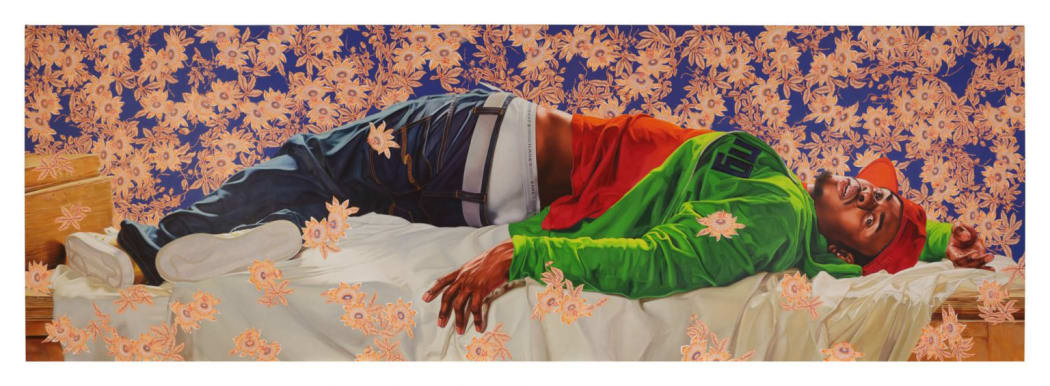
The journey of black art collectors is one marked by both resilience and revelation. From the early pioneers who sought to preserve and celebrate African and African American art to contemporary collectors who are broadening the horizons of art investment, their impact is indelible. These collectors are not just amassing artworks; they are curating collections that tell stories, evoke emotions, and challenge preconceptions. Their contributions extend beyond personal galleries into the broader cultural fabric, influencing exhibitions, museums, and the global art market.
As we explore the evolving landscape of art collection, we will uncover the historical roots of black art collecting, the challenges and opportunities faced by collectors, and the remarkable examples that illuminate their journey. Through this exploration, we aim to highlight how black art collectors are not only shaping the future of art investment but are also crafting a more inclusive and representative art world.
Outline:
- Introduction to Black Art Collectors
- Historical Context and Pioneers
- The Role of Black Art Collectors in Today's Market
- Challenges and Opportunities
- Examples and Case Studies
- Future Perspectives
- Conclusion
Introduction to Black Art Collectors
The realm of art collection has long been an exclusive enclave, often inaccessible to diverse narratives and voices. However, the emergence of black art collectors has initiated a paradigm shift, transforming the art world into a more inclusive and representative space. These collectors, driven by a deep appreciation for cultural heritage and artistic expression, are not merely accumulating artworks; they are preserving history, celebrating identity, and fostering a profound understanding of the black experience through visual narratives. They are custodians of the nuanced narratives of the global Black experience.
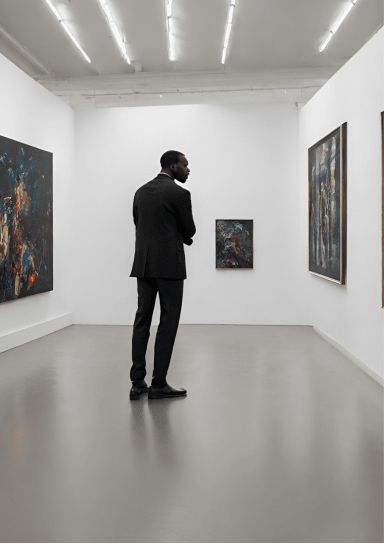
Black art collectors come from various backgrounds, each bringing a unique perspective to their collection. From entrepreneurs and professionals to artists and cultural enthusiasts, these individuals share a common goal: to elevate and spotlight black artists whose works have historically been marginalized or overlooked. By doing so, they play a crucial role in not only recognizing but also valuing the contributions of black artists to the global art canon.
The impact of black art collectors extends beyond personal collections. Many are actively involved in community engagement, using their collections as educational tools and platforms for dialogue. Through exhibitions, loans to museums, and public talks, they demystify the art collection process and encourage broader participation in the arts. This democratization of art collection serves to inspire new generations of collectors and artists alike, fostering a vibrant ecosystem that nurtures diversity and creativity.
Moreover, black art collectors are instrumental in challenging the traditional norms of art valuation and investment. By prioritizing works that resonate with cultural, historical, and emotional significance, they are redefining what is considered valuable in the art market. This shift not only broadens the scope of investable art but also highlights the importance of cultural and social factors in determining an artwork's worth.
In embracing the richness of black art, these collectors are not just preserving artifacts; they are safeguarding stories, traditions, and legacies. Their collections serve as a testament to the resilience, beauty, and complexity of the black experience, offering a more nuanced and inclusive narrative of art history. As we continue to explore the influence of black art collectors, it becomes evident that their contributions are pivotal in shaping a more equitable and diverse art world.
Historical Context and Pioneers
The legacy of black art collecting is a mosaic of stories, each piece a testament to the resilience, vision, and passion of individuals who have navigated the complexities of cultural preservation and representation. This journey into the annals of history reveals not just a collection of art, but a rich tapestry of resistance, identity, and heritage.
In the early 20th century, during a period marked by significant racial challenges and limited access to mainstream art markets, pioneering black collectors began to forge a path for the recognition and celebration of black artists. These early collectors, often unsung heroes, were motivated by a desire to see their experiences and histories reflected in art. They sought out works that resonated with the African and African American experiences, thereby creating a foundation for what would become a vibrant and dynamic field of collection.
Among these pioneers were individuals like Paul R. Jones and Peggy Cooper Cafritz, whose collections have become legendary for their depth, diversity, and the stories they tell of the African American experience. Jones, for instance, amassed one of the largest and most comprehensive collections of African American art, which he generously donated to the University of Delaware and the University of Alabama, ensuring public access and academic engagement with these important works.
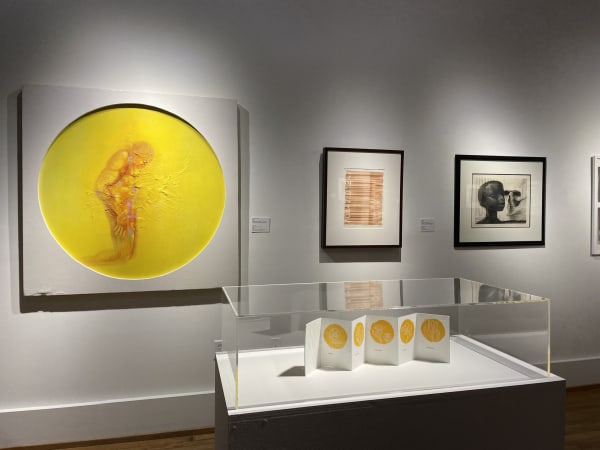
Paul R. Jones collection. Image courtesy of Paul Jones Museum
The impact of these early collectors extends beyond their personal achievements. They challenged the status quo, advocating for the inclusion of black artists in museums, galleries, and academic discourse. Their efforts laid the groundwork for a more inclusive art world, one in which the richness of black culture could be celebrated and studied.
Furthermore, these pioneers served as mentors and inspirations for subsequent generations of collectors. They demonstrated the power of art as a tool for cultural expression, community engagement, and social change. Their legacy is a beacon for today's collectors, reminding us of the transformative potential of art collection.
As we delve deeper into the stories of these early black art collectors, we gain not only an appreciation for their contributions but also a deeper understanding of the role that art plays in reflecting and shaping our world. Their pioneering efforts continue to inspire a new generation of collectors, ensuring that the narrative of black art remains vibrant and ever-evolving.
The Role of Black Art Collectors in Today's Market
In the contemporary art world, black art collectors play an indispensable role, not just as custodians of cultural heritage, but as influential figures shaping art trends and market dynamics. Their engagement and investments are pivotal in elevating the visibility and appreciation of black artists, thereby altering the landscape of the art market to become more inclusive and diverse.
Today's black art collectors are a dynamic and diverse group, comprising individuals from various professions, interests, and backgrounds. This diversity brings a rich palette of tastes and perspectives to the art world, significantly contributing to the broadening of the art market's scope. By actively seeking out and investing in works by black artists, these collectors are directly impacting the artists' careers, providing them with the recognition and financial support necessary for their continued growth and development.
Moreover, the influence of black collectors extends beyond individual acquisitions. Many are involved in philanthropic activities, founding or supporting galleries, museums, and educational programs dedicated to black art. These initiatives not only provide platforms for emerging and established black artists but also enhance public access to black art, fostering a greater understanding and appreciation among broader audiences.
The rise of digital platforms and social media has further amplified the impact of black art collectors. Through online galleries, virtual exhibitions, and social media campaigns, they are able to reach a global audience, bringing unprecedented attention to black artists and their works. One example of this is Laolu Senbanjo, a Nigerian visual artist and body painter, who gained international fame through social media. This was further increased after Beyonce discovered his unique style of body painting and offered him a collaboration on her Lemonade album [1]. This digital engagement is democratizing art collection and investment, making it more accessible to a wider audience and encouraging a new generation of collectors.
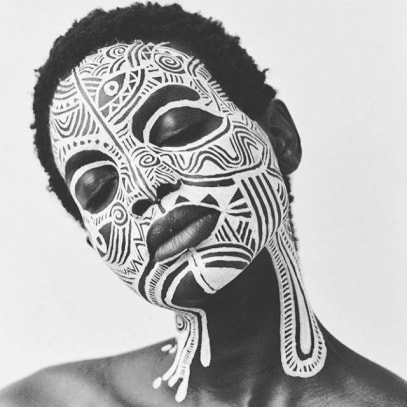
Sacred art of the Ori by Laolu Senbanjo. Imge courtesy of the artist
One notable example of a black art collector who has leveraged social media to bring unprecedented attention to black artists and their works is Swizz Beatz, also known as Kasseem Dean. Swizz Beatz, a renowned music producer, rapper, and DJ, alongside his wife, Grammy Award-winning singer Alicia Keys, has become a significant figure in the art world, particularly for his support and promotion of black artists.
Swizz Beatz co-founded The Dean Collection, an extensive private collection featuring works predominantly by black artists. What sets Swizz Beatz apart is his innovative use of social media platforms to showcase and highlight the works of these artists. Through Instagram and other social media channels, he has created a digital space where art enthusiasts, collectors, and the general public can discover and appreciate the art of black creators. His platform, "No Commission’, is a revolutionary art fair that allows artists to retain 100% of the proceeds from their sales, further emphasizing his commitment to supporting artists' financial independence and exposure.
His active presence on social media has not only elevated the profiles of numerous black artists but has also encouraged a broader conversation about the importance of black art in contemporary culture. Swizz Beatz's approach to collecting and promoting art is a testament to the power of digital platforms in transforming the art market, making it more accessible and inclusive.
In the current market, the role of black art collectors is multifaceted. They are not only driving financial investment in black art but are also instrumental in shaping cultural narratives and fostering a more equitable and representative art world. Their contributions challenge traditional market norms and pave the way for a future where art is valued not only for its aesthetic appeal but also for its cultural significance and ability to inspire social change.
Challenges and Opportunities
The journey of black art collectors is one of profound passion and purpose, yet it is not without its challenges. Navigating the art world can present unique hurdles for black collectors, from accessibility and representation to the valuation and recognition of black art. However, within these challenges lie significant opportunities for growth, diversity, and cultural enrichment in the art market.
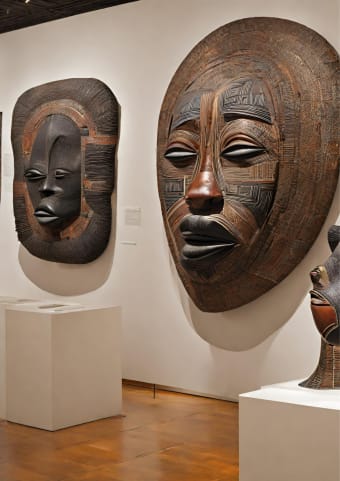
African Art collection, AI. Image: Pavillon54
Challenges
One of the primary challenges faced by black art collectors is the historical underrepresentation and undervaluation of black artists in the art world. This systemic issue has roots in broader societal biases and can make it difficult for collectors to find, acquire, and promote works by black artists within the traditional art market structures.
Additionally, the lack of diversity in art institutions and galleries can pose barriers to entry for black collectors looking to expand their collections or gain recognition for their contributions. These institutional barriers, coupled with limited access to networking opportunities, can hinder the visibility and impact of black art collections.
Opportunities
Despite these challenges, the landscape is ripe with opportunities for black art collectors to make a lasting impact. The growing awareness and appreciation of diversity in art are opening doors for more inclusive representation in galleries, museums, and exhibitions. This shift presents a chance for black collectors to play a pivotal role in reshaping the art world to reflect a broader spectrum of experiences and narratives.
In embracing these opportunities, black art collectors can leverage their influence to champion diversity, drive change, and ensure that the art world becomes a more inclusive space where black artists and their works are celebrated and valued.
Changing the Narrative and Image
Another crucial opportunity for black art collectors lies in their ability to change the narrative and image the world has about black people, fostering a sense of pride and acknowledging the immense contributions of black culture to history and popular culture. By strategically collecting and showcasing art that reflects the depth, diversity, and dynamism of black experiences, collectors can challenge and redefine stereotypical representations, offering more nuanced, positive, and empowering images of black identity.
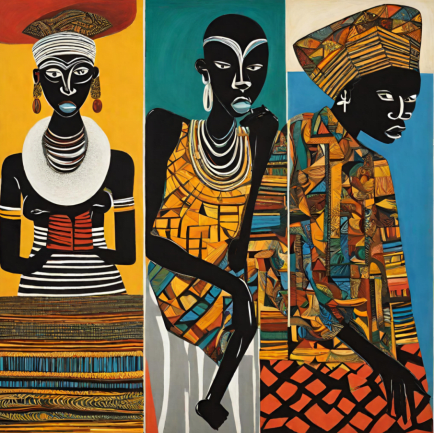
Art has always been a powerful medium for storytelling, and black art collectors wield this power to highlight the achievements, struggles, and resilience of black communities. Through their collections, they can illuminate the historical significance of black culture, its influence on modern society, and its undeniable impact on global art movements, music, fashion, and more. This not only enriches the cultural landscape but also instills a sense of pride and belonging among black individuals and communities worldwide.
Moreover, by bringing black art to the forefront of the global art scene, collectors play a pivotal role in educating broader audiences about the richness of black culture and its contributions to our collective history. This educational aspect is vital, as it builds bridges of understanding and appreciation, counteracting ignorance and prejudice.
The opportunity to change the narrative extends beyond individual collections. Black art collectors, through their platforms, collaborations, and public engagements, can influence how black culture is perceived and valued in the broader societal context. Their advocacy and visibility can lead to more inclusive cultural policies, curricula, and media representations, ensuring that the contributions of black individuals and communities are recognized and celebrated.
In embracing this opportunity, black art collectors do more than collect art; they become custodians of culture and agents of change, crafting a legacy that transcends aesthetic value and becomes a cornerstone for cultural pride and historical recognition.
Financial and Social Status Potential
The act of collecting art carries with it not only cultural and educational significance but also considerable financial and social status potential for both established and aspiring black art collectors. The art market, while complex, offers opportunities for savvy collectors to see significant appreciation in the value of their collections over time. As the demand for diverse and underrepresented artists grows, artworks that were once overlooked or undervalued can become highly sought after, yielding substantial returns for those who have invested early in their careers.
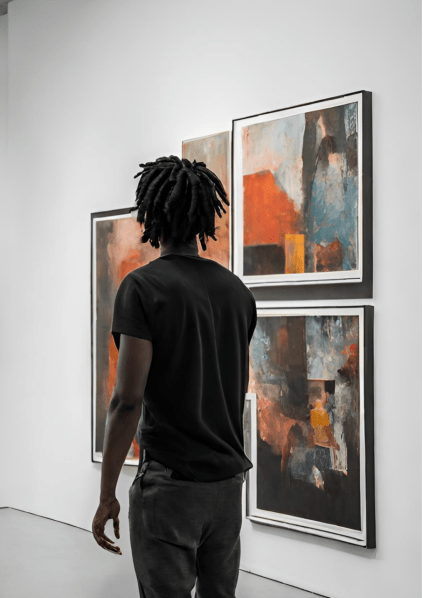
For established collectors, this financial aspect reinforces their status within both the art world and broader society, positioning them as influential figures whose choices can sway market trends and highlight emerging talents. Their collections can serve as a testament to their foresight, taste, and commitment to cultural preservation, enhancing their social capital and legacy within the community.
Aspiring black collectors, on the other hand, stand to gain immensely from entering the art collection sphere. Beyond the potential financial returns, the act of collecting art can serve as a powerful means of networking, providing access to a community of artists, galleries, curators, and fellow collectors. This social aspect can be particularly valuable, offering mentorship opportunities, access to exclusive events, and collaborations that can elevate one's social standing and influence.
Moreover, for both established and aspiring collectors, the pursuit of art collection can be a form of wealth-building that transcends traditional investment avenues. It offers a unique blend of financial opportunity and cultural engagement, allowing collectors to contribute to the arts while potentially securing their financial future.
The social prestige associated with art collection can have far-reaching implications, extending beyond personal recognition to fostering greater respect and visibility for black art and artists. As collectors gain prominence, they can use their platforms to advocate for change, challenge existing narratives, and promote diversity and inclusion within the art world and beyond.
Examples and Case Studies
The world of black art collecting is rich with stories of individuals whose passion and dedication have significantly influenced both the art world and broader cultural landscapes. These case studies of prominent black art collectors not only highlight their contributions but also serve as an inspiration for aspiring collectors.
Swizz Beatz and Alicia Keys
As mentioned earlier, Swizz Beatz, along with his wife Alicia Keys, has made a substantial impact on the art world through The Dean Collection. Their commitment to "No Commission" art fairs has revolutionized the way artists sell their work, ensuring they retain full profits. This model not only benefits the artists financially but also challenges traditional art market structures, advocating for more equitable artist-collector relationships.
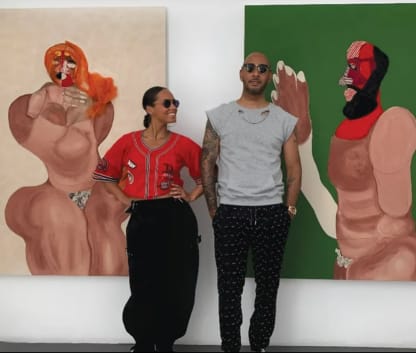
Alicia Keys and Kasseem “Swizz Beatz” Dean with paintings by Tschabalala Self. Image courtesy of SWIZZ BEATZ
Peggy Cooper Cafritz
Peggy Cooper Cafritz, co-founder of the Duke Ellington School of the Arts in Washington D.C., was renowned for her expansive collection of African American and African diaspora art. Following a devastating fire that destroyed much of her collection, Cafritz redoubled her efforts, rebuilding a collection that continued to celebrate and elevate black artists. Her legacy is one of resilience, passion, and an unwavering commitment to cultural representation and diversity in art.
Bernard and Shirley Kinsey
Bernard and Shirley Kinsey have dedicated their lives to uncovering and sharing the often overlooked contributions of African Americans through their extensive collection of art and historical artifacts. The Kinsey Collection has been exhibited across the United States, including at the Smithsonian National Museum of American History, providing educational insights into the black experience from the 17th century to the present.

Recreating the pose in a portrait, Shirley and Bernard Kinsey are the owners of more than 100 African American artifacts and works of art currently on display at the Brogan.
Pamela Joyner
Pamela Joyner, through her extensive collection of African American art, has focused on rectifying the historical underrepresentation of black artists in the art narrative. Joyner's efforts extend beyond collecting; she actively works to ensure that these artists are included in mainstream museums and educational curricula, thereby influencing how art history is taught and understood.
These examples underscore the varied roles black art collectors play in championing black artists, reshaping market dynamics, and influencing cultural narratives. Their stories are a testament to the power of collecting not only as an act of preservation but as a dynamic form of cultural advocacy and social engagement.
Future Perspectives
As we look towards the horizon, the role of black art collectors in shaping the future of art investment is poised for unprecedented growth and influence. The evolving landscape of the art world, fueled by technological advancements, shifting cultural norms, and a growing emphasis on diversity and inclusion, presents a fertile ground for black collectors to further assert their presence and impact.
Technological Advancements
The digital revolution has democratized access to the art market, enabling collectors to discover, purchase, and promote art from anywhere in the world. Online galleries, virtual exhibitions, and digital marketplaces are removing traditional barriers, allowing black art and artists to gain global visibility. As technology continues to evolve, we can expect black art collectors to leverage these platforms not only to expand their collections but also to foster a global appreciation for black artistic expression.
Cultural Shifts
There is a palpable cultural shift towards recognizing and celebrating diversity in all forms of creative expression. This movement is dismantling long-standing prejudices and opening up new opportunities for black artists and collectors. As societal awareness and appreciation of black culture continue to grow, the demand for art that reflects these diverse experiences and narratives will increase, enhancing the cultural and financial value of such works.
Increased Representation and Advocacy
Black art collectors are becoming increasingly influential as advocates for change within the art world. By supporting black artists, curating inclusive exhibitions, and engaging in dialogue about diversity and representation, collectors are at the forefront of a movement toward a more inclusive art narrative. This advocacy is not only elevating the status of black art but is also ensuring that black voices are heard and respected in the conversation about art and culture.
Investment and Legacy Building
The future also holds significant potential for black art collectors to impact the art investment landscape. As the market for black art continues to grow, both in popularity and financial value, collectors stand to make substantial returns on their investments. Beyond financial gains, these collectors are building legacies that will influence generations to come, ensuring that black art is permanently etched into the annals of art history.
Community Engagement and Education
Finally, the future of black art collecting is deeply intertwined with community engagement and education. By sharing their collections with the public, participating in educational programs, and supporting art education in underserved communities, black collectors are playing a crucial role in nurturing future artists and collectors. This grassroots approach to art education is vital for sustaining and growing the ecosystem of black art and ensuring its continued relevance and impact.
Conclusion
The narrative of black art collectors is one of profound impact and transformation. Through their dedication and visionary approach, these collectors are not only preserving the rich tapestry of black culture but are also actively shaping the future of art investment. Their efforts extend beyond personal collections, influencing the global art market, and more importantly, altering societal perceptions of black art and artists.
The journey of black art collectors, highlighted by the challenges they've overcome and the opportunities they've embraced, underscores a broader movement towards inclusivity and diversity in the art world. By championing underrepresented artists and advocating for equitable practices, these collectors are dismantling long-standing barriers, making the art world a more accessible and representative space for all.
The examples and case studies of prominent collectors such as Swizz Beatz, Peggy Cooper Cafritz, and Pamela Joyner, among others, serve as both inspiration and testament to the power of collecting with purpose. Their legacies remind us that collecting art is not merely an act of acquisition but a profound expression of cultural identity, social responsibility, and visionary leadership.
In conclusion, the influence of black art collectors is a beacon of change, illuminating a path toward a more inclusive, equitable, and vibrant art world. Their legacy is not only in the works they collect but in the barriers they break and the doors they open for future generations of artists and collectors alike.
